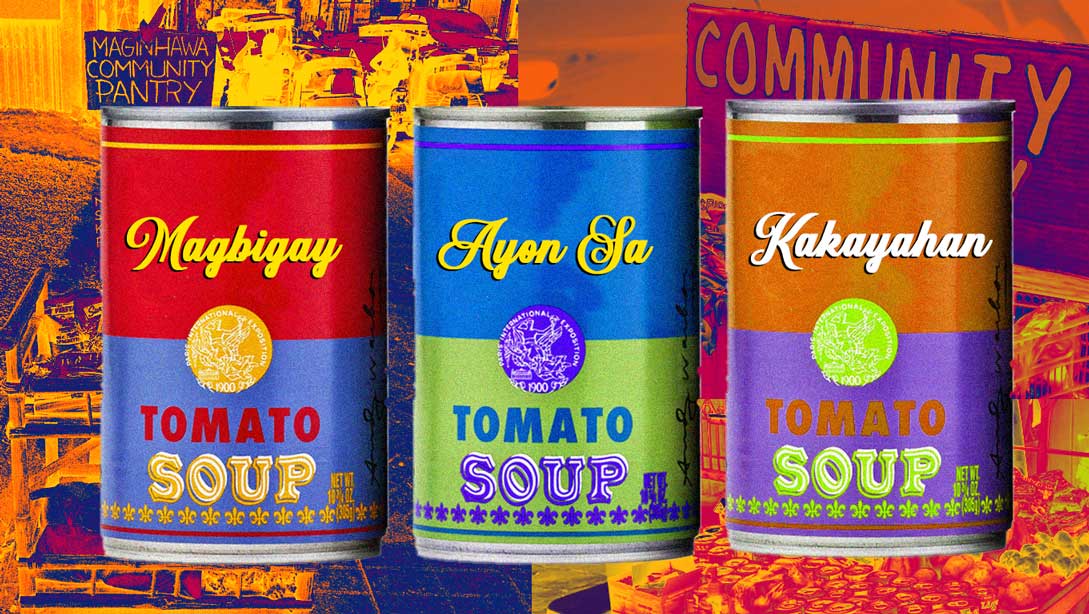Tiny, nondescript, but powerful, the humble community pantry has proven that when push comes to shove, people will come together in kindness and compassion.
“Magbigay ayon sa kakayahan, kumuha ng batay sa pangangailangan,” and so goes the moral code that sets precedent to every community pantry that has now become a fixture of function in every many streets across the country. Shifting from a singular inspiring story to a phenomenon that has inspired a nation to action, this is more than just the snaking long lines that lead up to the mostly make-shift spots. Whether driven by necessity or the human urge to help, the community pantry has trickled into the consciousness of the citizens, expanding their perspectives beyond their immediate periphery.
“Ang hirap mabuhay ngayon. Affected ‘yung negosyo ko, wala masyadong pumapasok na income. And ‘yung sakto lang ‘yung meron ako sa everyday na gastusin. Ang goal lang natin is mabuhay and mag-survive, tapos magpalakas. Kung magkasakit naman po, magpagaling. Ginawa ko naman siya pero ‘di mawala sa isip ko na may mga taong hindi kayang gawin ‘yung stay safe, stay home, kasi po nakasalalay ‘yung pagkain po nila sa araw–araw din na livelihood,” details Ana Patricia Non in an interview with The Source. “Sabi ko, after ng lockdown, before ako bumalik sa trabaho, ise-setup ko ‘tong community pantry. At least meron pong pangtawid gutom para sa Pilipinong ganun ang nararamdaman.”
Driven by a sense of survival that is beyond her, the community pantry that she began in Maginhawa stood to be a radical act in itself. Easy to set up, with no strict requirements, other than the currency of honesty and safety health protocols, and best of all, free, this was defiant in its decision to fill the obscenely gaping void left unattended by the blatant mismanagement of the government in this unrelenting crisis. It is nothing out-the-ordinary. Occupying a roadside space in Maginhawa, in a city of concerning unemployment and poverty, the community pantry stood there—tiny, nondescript, but powerful.
“Natuwa po ako na kino-continue po ng mga tao at na-appreciate ko po ‘yung response, masaya po ako,” Non continues. “Pero at the same time, hindi mawawala ‘yung lungkot na siguro kaya din nila isinet-up ito kasi nakita nila ‘yung pangangailangan ng mga kababayan nila, mga ka-community nila.”
Related: SO, WHAT IS HAPPENING? THE PANDEMIC IN THE PHILIPPINES BY THE NUMBERS SO FAR
The Community Pantry Has Exposed The Gaps In The Pandemic Response
There is a lot to unpack here, and we are not just speaking of the goods that have been donated, because as impressive and motivating as it is, we have to be mindful of the problems and issues that have thoroughly crippled the country today. Riddled by record unemployment and economic inflation, as well as of the dismal cash assistance tepidly distributed by the government and its agencies, the simple rational of the citizen-led community pantry initiative now growing exponentially across the Philippines is the response desperately needed for families to survive.
Here, it is the people who are practically left on their own by the fundamental refusal of responsibility of the powers that may be that are doing the work they should be doing—feeding, helping, and giving hope to the most vulnerable. No longer able to stomach another day of families subsisting on what isn’t even close to the bare minimum, it is the ordinary people that are taking matters into their own hands. There is no more “bahala na” in this situation. To assuage dread and desperation, the collective feeling of doing something has risen—and it hasn’t relented to this day.
“Nililigtas po natin ang mga tao. Salubungan po ‘yung tulungan,” says Ana Patricia Non, expressing how the community pantry meets the people and its needs to where they are. “Ito po talaga ang kailangan ngayon.”
Where Systems Fail, The People Come Together
Hunger and poverty isn’t an isolated case, and it has been made more clear in the pandemic. With figures dangling at the range of 7.6 million households, 2.2 million of which accounts itself as severe, nearly a third of the Philippine population are being deprived of the basic right to eat. Further more, 10.9 million Filipinos have lost jobs in collateral to the COVID-19 crisis. And instead of coming in to make lives easier, as they are mandated to do, the government has concerned itself with other matters other than the coronavirus, which also has seen record-breaking numbers of active cases as of late.
Clearly, the systems that are meant to service the Filipino people have failed and while the rest are languishing, the people took it upon themselves to make things a little better in their own way. Spreading across the far regions of the country, the community pantry has struck a chord among many, perhaps illustrating that it doesn’t take much to help, even with the meager finances at our disposal.
“Ang community pantry, hindi siya judgmental. Kahit gaano kalaki o gaano kaliit ang kaya mo ibigay, tatanggapin namin,” assures Non. “Malaya ‘yung pantry. Ganun din ang natutunan nating Pilipino. Malaya…walang pinipiling tao and nagbigay siya ng hope sa ating lahat na magtulungan tayo na kahit hirap ‘yung panahon ngayon. Ito ‘yung something na sabi nga ng mga tao: Salamat kasi parang nabuhayan sila ng loob tumulong. Gusto nila tumulong, ngayon lang nagka venue na tumulong.”
The Community Pantry Is An Act Of Deliberate Resilience
It is easy to understand why at this point, people have grown weary to the word, resilience. Despite being glorified and romanticized to distract from the real issues at hand, it cannot be denied how even at the expense of the people and their limits, the community pantry is a rousing act of resilience that has taken the country by storm. Unlike in the context of typhoons, where resilience takes over ratified response and relief operations, there is no top-down leader in this growing sense of community. Here, where everything is horizontal and equal, the people, with their energy and pride ushered into its proper lanes of expenditures, are saying: today, we will survive.
Think about it: we wouldn’t have been backed into this corner had there been a more strict and swift action that is backed by science and pertinent policies. Just like the storms that we face, the pandemic is a brute force of nature that we should have been prepared for. So, instead of trailing the rest of the world as it inches towards a semblance of normal, we are left on our own yet again.
But this time, there seems to be a stronger will to reclaim resilience from being peddled as a character trait unique to our race. Instead, we are using it for character development at the grassroots level. With the human ability to coordinate and communicate, the concept of the community pantry is a further illustration of how we can achieve cultural marvels in history and evolution. Who else to help each other out but ourselves, right?
Helping Is A Cycle
Doing is everything. And it doesn’t even take something groundbreaking to get the ball rolling. From the bamboo cart in Maginhawa to community libraries, community pawntries (a version for pets), and a rainbow community pantry, everyone will want to help. “Hindi naman po siya charity na isa lang po ang tinutulungan,” reasons Ana Patricia Non. “Kelangan ng extra support sa mamayan.”
Asking nothing return, the effect of compassion is circular. Take Tatay Elmer Cordero for example, one of the jeepney drivers of the Piston 6 unjustly arrested and put to jail by the police last year. Recalling the help that was extended to him in his moment of struggle, he says it his turn to give back through the “Tulong Obrero Community Pantry” that was put up for the drivers with no source of income. “Panahon naming ngayon para tumulong at magbigay dahil napakarami pa ring nangangailangan.”
Expanding its reach far than one might think, the effect of the community pantry ripples beyond the lines and bags of goods. The amount they will be able to save from the efforts of the community, for example, means money saved for other pressing matters in the family: mobile online learning classes, utilities, rent, fare for commuting…the list goes on. Needless to say, it is a lot, especially for the 4 million Filipinos who were unemployed this year alone. More than just feeding them food, this undertaking essentially guarantees them a future. Resilience, in this overarching situation, means seeing better things, which you want to actually live through.
No matter where you look at it from, the community pantry gets them through the day.
See, when people are made to feel like people, when you trust them, when you let them do what they can, they will do it. There is no grandstanding, no name-calling, no bureaucracy—just pure kindness.
The Spirit Of Community Will Not Be Stopped
While the community pantry isn’t perfect, especially in its early days, it certainly has found its footing as evidenced by the adoption of like-minded citizens and LGUs in their own corners of the country. But for all the steps forward it has taken, being able to give families equal opportunities at sustenance, the system of sociality that was in place was robbed from giving more, because it has fallen prey to the malicious red-tagging and misinformed reports of alleged links to the operatives of the communist party in the Philippines. Vehemently denied by Ana Patricia Non, whose only intent was to help those she can in the best way she knows how, the community pantry in Maginhawa halted its functions for a day, just to be able to clear things with the task force involved, as well as of the police force and local government office.
In spite of this, the hunger to help grew stronger beyond the humble street in Quezon City. Donations were reallocated and families lining up were told to return the next day or redirected to nearby community pantry spots. More efforts and undertakings sprang forth, proving that you cannot put an end to the good and the spirit of community.
It is a tale as old as time. The more you force a narrative that is far from the actual truth, the more it will become a bigger, booming voice that tells the story as it should. The more people are told not to do something, the more they will be encouraged to do so, especially when there is no harm done. This is the ultimate nature of bayanihan and no amount of ego can stall its progress to higher ground. With no end on sight, it’s all systems go for the community pantry, except this time, more people are at it, holding accountability and responsibility where others have failed to do so.
With every step taken in the name of bayanihan and resilience, we are reminded again of what sits at the core of the community pantry: Take what you need, give what you can. In this deliberate exchange, a lot more can be taken away than just the tangible essentials. Only time will tell, but who knows, this could signal the start of a better, healthier, more compassionate Philippines.
And it goes without saying, for what its worth in the streets: kindness really goes a long way.
CONTINUE READING: THERE’S A REASON WHY YOU WILL HAVE TO WAIT FOR YOUR TURN TO GET VACCINATED





